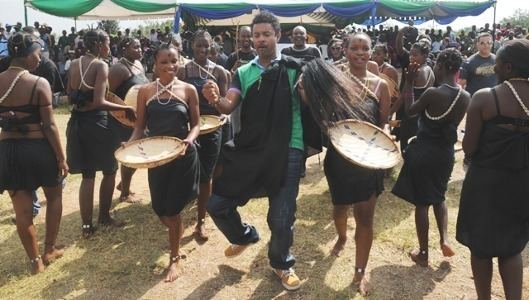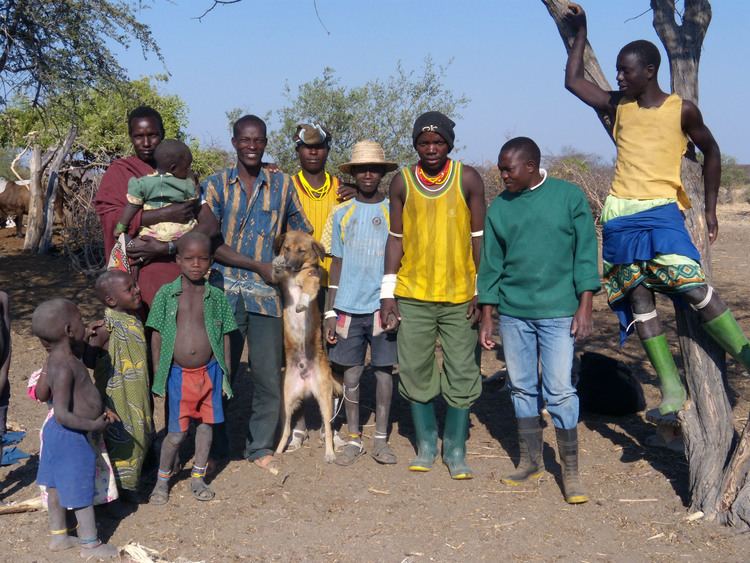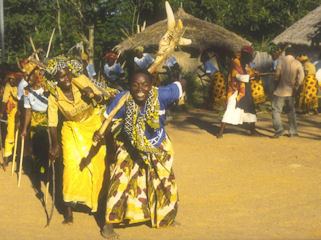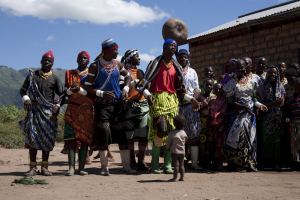 | ||
The Sukuma are a Bantu ethnic group inhabiting the southeastern African Great Lakes region. They are the largest ethnic group in Tanzania, with an estimated 8.9 million members or 16 percent of the country's total population. Sukuma means "north" and refers to "people of the north." The Sukuma refer to themselves as Basukuma (plural) and Nsukuma (singular). They speak Sukuma, which belongs to the Bantu branch of the Niger-Congo family.
Contents

The Sukuma live in northwestern Tanzania on or near the southern shores of Lake Victoria, and various areas administrative districts of the Mwanza, southwestern tip of Mara Region, Simiyu Region and Shinyanga Region. The northern area of their residence is in the famous Serengeti Plain. Sukuma families have migrated southward, into the Rukwa Region and Katavi Region, encroaching on the territory of the Pimbwe. These Sukuma have settled outside Pimbwe villages.

The Sukumaland is mostly a flat scrubless savannah plain between 910 and 1,220 metres (3,000 and 4,000 ft) elevation. Twenty to forty inches (51 to 102 cm) of rain fall from November to March. High temperatures range from 26 to 32 °C (79 to 90 °F) while lows at night seldom drop below 15 °C (59 °F). Population is very spread out among small farm plots and sparse vegetation.
History

As with the Nyamwezi, all members of the five groups in 'Greater Unyamwezi' identified themselves as Wanjamwezi to those outside of the 'greater' area, but among themselves used Sukuma, Konogo, and so on. The Wasukuma call themselves, Sukuma, (Northerners) when speaking to Nyamwezi, but use Nyamwezi when speaking to anyone else. It can be called the Nyamwezi-Sukuma complex, for while never united, they were very closely related in attitude and way of life. Like most of their neighbors they were an ethnic group divided into many smaller groups. Some claim they were a Nyamwezi people who had moved northwestward to escape Mirambo's raids with the result that game and tsetse re-occupied the deserted area.

Unyanyembe, the most important chiefdom of the Wanjamwesi, centered on Tabora, obtained its meat supplies from the Sukuma. By 1892, however, the herds of cattle began to decline due to rinderpest and tsetse fly, and while two-thirds of German East Africa became unsuitable for cattle, and cattle in general probably did not recover until after the First World War; large valuable herds of cattle were retained by the Sukuma who were then still able to escape any great social change by exploiting the herds economically. Sukuma tradition suggests that famine did become more common towards the end of the nineteenth century, leaving conservative Sukuma blaming religious innovation for the natural disasters and expecting regular sacrifices for the household or chiefdom ancestors.
As all Nyamwesi, the Sukuma, being agriculturalists, ridged their fields to accommodate the fertile but rather arid region. At the same time they had herds, having acquired them from the Tatoga people, but since 'mixed' farming was practiced they were not considered pastoralists. Usakma also contained and used iron deposits, re-exporting some 150,000 iron hoes to Tabora.
Culture
The Sukuma believe in spirit possession and have a holistic lens of viewing the world as interconnected with all living things, natural and supernatural.
Social relationships
Relationships between the Sukuma and their non-Nyamwezi neighbors, the Tatoga, were generally good and they did not regard each other as enemies. They needed one another. The Tatoga needed the grain of the Sukuma while the Sukuma needed the cattle and the highly regarded rainmaking diviners of the Tatoga. (Rainmaking experts of the Tatoga were considered the very best at this important and highly specialized activity. The Masaai, however, in contrast to the Tatoga, were considered enemies. The Tatoga-Sukuma relationship was centered on cultural and economic exchange, while the Sukuma-Masaai connection was centered in fear and hatred, for cattle were the only thing the Masaai wanted from the Sukuma, believing that God had granted the Masaai all the cattle in the world, it is still possible that some peaceful relationship did exist. The Sukuma were very selective in what they assimilated, just as the Nyamwesi were, they were able to assimilate others but were unable to assimilate themselves into other societies. One Sukuma myth states that the Tatoga (Taturu) were their leaders and chiefs when they migrated from the north; the Taturu were the cattle herders and needed open plains for their cattle and moved on into the greater Serengeti area. The Sukuma were left closer to the big Nyanza (Lake Victoria), cleared the forests and became the agriculturalists. Even then, when the Taturu moved out toward the plains, they left Taturu administrators to "rule" over the Sukuma. For this reason, up until the time of the dissolution of the chieftain system, all chiefs and major headmen represented themselves as Taturu even though they were now within the Sukuma area.
Sukuma and Nyamwezi
The Nyamwezi (are also called Wadakama, or people of the South) and Sukuma (also called people of the North) are two closely related ethnic groups that live principally in the region to the south of Lake Victoria in west-central Tanzania. When using ethnic names, they describe themselves as "Banyamwezi" (sing. Munyamwezi) and "Basukuma" (sing. Musukuma) respectively; they refer to their home areas as "Bunyamwezi" or "Unyamwezi," and as "Busukuma." The term "Sukumaland" is sometimes used for the Sukuma area. The name "Sukuma" literally means "north," but it has become a term of ethnic identification.
The Nyamwezi and Sukuma region lies between 2°10′ and 6°20′ S and 31°00′ and 35°00′ E. The Nyamwezi "home" area is in Tabora Region and western Shinyanga Region, and Sukumaland lies to the north and east, covering eastern Shinyanga Region and also Mwanza Region. There has been much population movement in and beyond these areas, and members of both groups have also settled on the coast and elsewhere. Sukuma and members of other groups, such as the Tusi and the Sumbwa, are often found in Nyamwezi villages, but Sukuma villages are ethnically more homogeneous. Sukuma took over the Geita area of Mwanza Region during the colonial period, and they have expanded farther west since then. They have also moved down into Nzega District and the neighboring Igunga District, and some have migrated into the southern highland areas of Tanzania, and even into Zambia. These Sukuma movements have stemmed from political factors, such as colonial cattle-culling policies, and from local overcrowding and deteriorating soil conditions. The two areas form a large and undulating tableland, most of it at elevations between 1,150 and 1,275 metres (3,773 and 4,183 ft). There are several rivers in the region, but most of them do not flow during the drier months. The year can be broadly divided into a rainy season, from about November until April, and a dry season the rest of the year. Average annual rainfall is about 75 centimetres (30 in) for most of the Sukuma area, and about 90 centimetres (35 in) for Unyamwezi, but there is much variation from year to year and from place to place. Across the region, there is a regular sequence of soil and vegetation zones. The upper levels are dry woodland typified by trees of the Brachystegia-Isoberlinia association; these areas are often called miombo country, after one of these trees. Lower areas of grass and thornbush steppe are also common, and in Sukumaland there are large tracts of park steppe interspersed with baobabs.
